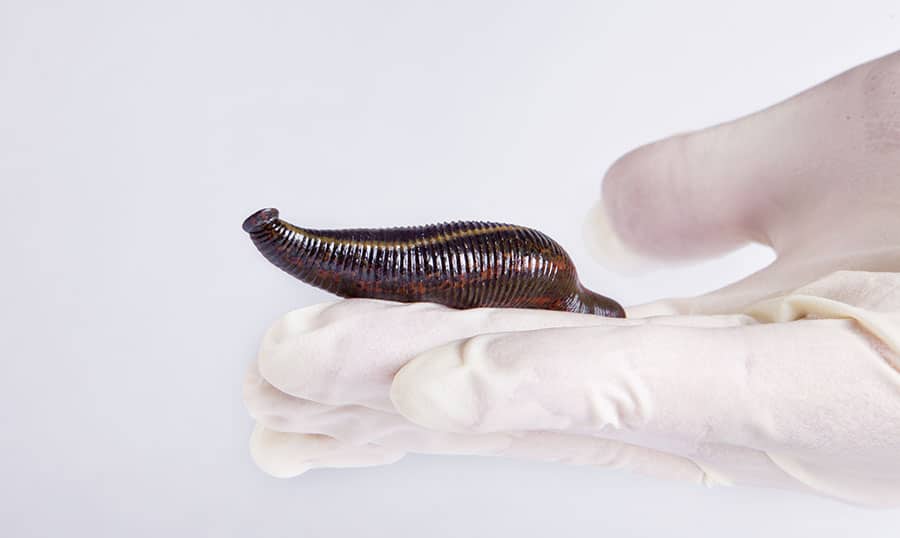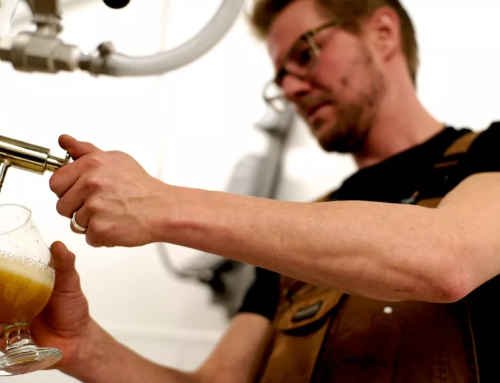Leech therapy for animals
To follow the training click here

Leech therapy is a traditional therapy recognised for a number of human ailments.
Many people are interested in treating the illnesses of their animals, such as dogs, cats, horses, cattle and pigs.
Thus, leech therapy has long been used to treat animals as well.
Leeches therapy - hirudotherapy for small animals (dogs, cats, rodents)
Medicinal leeches have in their saliva a number of medically effective substances, which are released into the wound of the bite during the process of sucking.
The leech's natural combination of active ingredients is unique.
The leech has been classified as a separate medicine in Germany since 2004.
As a result, leeches are subject to the safety, quality and efficacy requirements that apply to all medicines requiring marketing authorization.
The active ingredients of leeches promote local blood circulation in the area of the attachment site by inhibiting coagulation and help with painful inflammations.
Chronic diseases in dogs, cats and rodents can often be positively influenced by leech therapy due to the greatly improved metabolic situation, and there is a chance of relief and, in the best case, recovery.
What happens during leech therapy for animals?
A treatment for your pet, such as a dog or cat, usually takes between 60 and 90 minutes.
Depending on the indication, one application is often sufficient.
At the beginning of the treatment, the leech is placed on the targeted area of skin, it sucks in and carefully saws the skin with its chalky teeth.
During this process, the leech probably releases analgesic substances, as this procedure is almost painless for the animals.
The leech starts to release its active substances into the tissue and then falls off by itself.
With the active substance Calin (Saratin), the small bite wound remains open for 4 to 12 hours and bleeds continuously.
Many animals are relieved immediately after the leech treatment.
This feeling of well-being often lasts for months.
How does your dog or cat react to leeches?
Generally, dogs and cats accept the leech bite without any defensive reaction.
They usually tolerate the treatment with patience and snooze quietly during the treatment.
What are the risks of leech therapy for your pet?
Adverse drug reactions or side effects are very rare with leech therapy in animals.
Basically, there are risks of wound infection and allergic reactions, as well as risks of overdose, especially in small animals.
In addition, animals may have diseases for which leech therapy is not indicated.
For this reason, pet owners who practice self-medication are advised to identify with their veterinarians the unwanted effects that may occur with leech therapy in certain disease states.
Leech therapy for dogs

Animals instinctively know the healing power of leeches.
Cattle, water buffaloes, sheep and horses suffering from joint problems, for example, deliberately go to the waters where leeches live and wait patiently for the little helpers, by means of a bite, to take their tiny meal and, in return, leave their healing "cocktail of active ingredients" in the body of the sick animal.
Through the bite of the leech, which is not even perceptible to the bitten patient, a "cocktail of active substances" is injected into the animal's body, which has among other things an anticoagulant, anti-inflammatory and analgesic effect.
The blood circulation is increased locally, slag is removed and the animal's own regenerative processes are stimulated.
While the layman considers leeches to be slippery, bloody and disgusting, alternative practitioners appreciate the cocktail of active ingredients in these elegant and harmless swimmers as a healing alternative medicine.
Ancient civilizations have used the healing arts of leeching for thousands of years.
In short, leech therapy offers us an extremely well-tolerated remedy with a proven and lasting effect.
One of the leech's active ingredients, hirudin, is a world-renowned drug used in the treatment of various blood clotting disorders, including heart attacks.
Dogs, but also other animals such as horses and cats, are not irritated by leeches and do not resist their bite or try to get rid of the little worm.
In the meantime, leech therapy has been the subject of modern research, which has long since proven that the curative effect of this therapy is in no way based on a medieval superstition.
How does your dog react to leeches?
As a rule, dogs accept the leech bite without any defensive reaction.
They usually tolerate the treatment with patience and fall asleep quietly during the treatment.
Application of leech therapy in dogs
Below are some indications for leech therapy in dogs:
- Arthritis / Osteoarthritis
- Joint deformities, such as dysplasia, HD, ED (HD for hips, ED for elbows)
- Diseases of the ligament and tendon system
- Diseases of the spine, such as spondylosis, disc disease, cauda equina, etc.
- Neuritis, nerve irritation, nerve inflammation, for example ischialgia
- Lumbago
- Myogelosis, hardening of the muscles
- Eczema, also licking eczema, ear eczema, eczema between the toes
- Abscesses
- Mastitis, inflammation of the udder
- Wound healing disorders
- scarring problems, also in the postoperative period
- Haematomas, bruises
- Venous diseases, thrombosis, thrombophlebitis
- Lymphangitis, inflammation of the lymphatic system
- Diseases of the teeth and jaws
Leech therapy for cats
Application of leech therapy for cats
Below are some indications for cats and other small animals:
- Arthritis / Osteoarthritis
- Joint deformities, such as displasia, HD, ED
- Diseases of the ligament and tendon system
- Diseases of the spine, such as spondylosis, disc disease, cauda equina, etc.
- Neuritis, nerve irritation, nerve inflammation, e.g. ischialgia
- Lumbago
- Myogelosis, hardening of the muscles
- Eczema, also licking eczema, ear eczema, eczema between the toes
- Abscesses
- Mastitis, inflammation of the udder
- Wound healing disorders
- scarring problems, also in the postoperative period
- hematomas, bruises
- venous diseases, thrombosis, thrombophlebitis
- Lymphangitis, inflammation of the lymphatic system
- diseases of the teeth and jaws and other areas of application
Leech therapy for horses and ponies
Disorders of the musculoskeletal system of the horse often lead to tension or even pain, so that the horse no longer likes to move with gusto - this is where leech therapy for horses can be helpful.
In most cases, horses and ponies are happy to have leeches applied, as they instinctively know the beneficial effect.
Often one application is sufficient. In case of persistent complaints, a follow-up treatment is necessary. The leech is applied to the chosen spot.
When it bites, a whole cocktail of medically effective substances is injected into the small wound.
These spread locally and start working immediately.
Once the leech has finished sucking, a process that can take 60 to 90 minutes, it falls off by itself.
The wound, which continues to bleed for a few hours, is dressed with a bandage.
This post bleeding cleans the wound and is expressly desired.
Application of leech therapy on horses
Here are some of the conditions for which experienced therapists can provide effective help with leeches:
- Laminitis, acute and chronic
- Edema
- Haematomas, e.g. from kicking injuries
- Acute and chronic arthritis, inflammation of the joints
- Phlegmon, lumps, abscesses, mastitis, bumps
- spavin
- Inflammations of the pastern, joint galls of the pastern...
Leeching for livestock

The leech is placed exactly where the joint is inflamed, for example.
The leech works its way through the hair to the ideal spot for the bite and then attaches itself to the skin with its star-shaped Mercedes jaws.
Each of its chewing ridges has about 80 calcareous teeth with which it "saws" the cattle skin.
Once it is secured in the right place, it quickly starts the sucking process.
An exchange takes place.
The leech contains in its saliva effective substances that have, among other things, an anti-inflammatory and anticoagulant effect.
The leech used is about 7 years old and can absorb up to 50 ml of blood.
After sucking the inflammatory substances out of its host, it lets go and falls off by itself.
This process can take up to an hour.
Then the desired secondary hemorrhage occurs.
Now as much waste as the leech has already absorbed bleeds from the diseased area.
The secondary bleeding can last for several hours.
The treated area is dressed with a loose dressing (no pressure bandage).
Possible applications of leech therapy in cattle:
- Inflammation joint
- Mastitis
- Teat injury
- Wound healing disorders
- Narrowed teat canal
Leech therapy for pigs

The leech is placed exactly where the joint is inflamed, for example.
The leech works its way through the hair to the ideal spot for the bite and then attaches its jaws to the pig's skin.
Each of its chewing ridges has about 80 chalky teeth with which it "saws" the pig's skin.
Once it has docked in the right place, it quickly begins the sucking process.
An exchange takes place.
The leech contains effective substances in its saliva that have, among other things, an anti-inflammatory and anticoagulant effect.
The leech used is about 7 years old and can absorb up to 50 ml of blood.
After sucking the inflammatory substances from its host, it drops it and falls off by itself.
This process can take up to an hour.
Then the desired secondary hemorrhage occurs. Now as much waste as the leech has already absorbed bleeds from the diseased area.
The secondary bleeding can last for several hours.
The treated area is covered with a loose bandage (no pressure bandage!).
Application of leech therapy in pigs
Here are some disorders for which experienced therapists can provide effective help with leeches:
- Inflammation joint
- Mastitis
- Teat injury
- Wound healing disorders
- Blood ear
and other areas of application...
To follow the training click here










Please let me know more about leech therapy for my horses farm in Italy. Could you come and learn us you leech course on the field ?
Dear Luciano,
Write us directly to support@pretasurvivre.com and then look at course online description here on our https://www.pretasurvivre.com platform. We will study your offer for a consulting on the field 🙂 Thanks